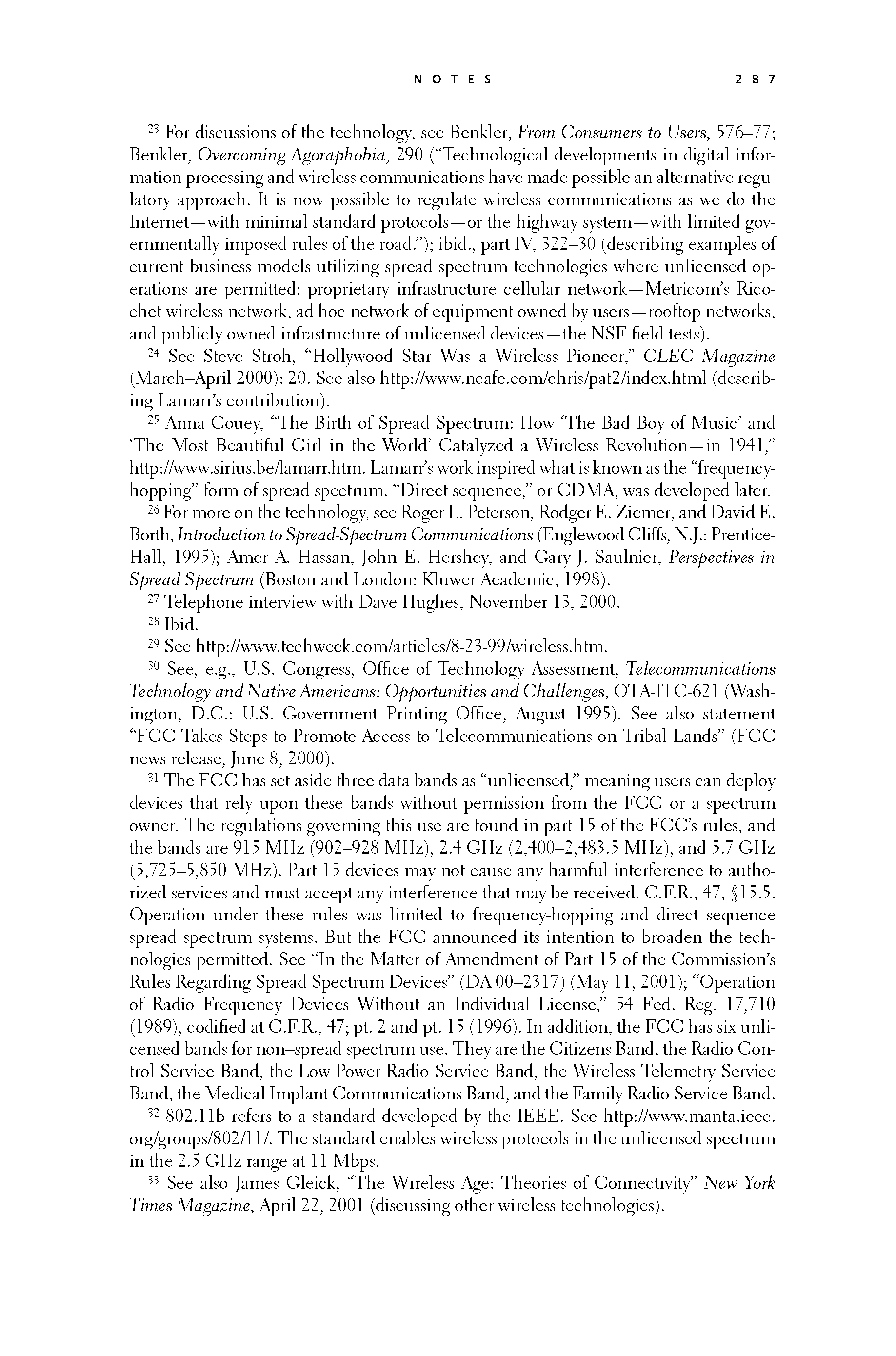 p286 _
-chap- _
toc-1 _
p287w _
toc-2 _
+chap+ _
p288
p286 _
-chap- _
toc-1 _
p287w _
toc-2 _
+chap+ _
p288
[5-23] For discussions of the technology, see Benkler, _From_Consumers_to_Users,_ 576-577;
Benkler, _Overcoming_Agoraphobia,_ 290 ("Technological developments in digital infor-
mation processing and wireless communications have made possible an alternative regu-
latory approach. It is now possible to regulate wireless communications as we do the
Internet -- with minimal standard protocols -- or the highway system -- with limited gov-
ernmentally imposed rules of the road."); ibid., part IV, 322-330 (describing examples of
current business models utilizing spread spectrum technologies where unlicensed op-
erations are permitted: proprietary infrastructure cellular network -- Metricom's Rico-
chet wireless network, ad hoc network of equipment owned by users -- rooftop networks,
and publicly owned infrastructure of unlicensed devices -- the NSF field tests).
[5-24] See Steve Stroh, "Hollywood Star Was a Wireless Pioneer," _CLEC_Magazine_
(March-April 2000): 20. See also http://www.ncafe.com/chris/pat2/index.html (describ-
ing Lamarr's contribution).
[5-25] Anna Couey, "The Birth of Spread Spectrum: How 'The Bad Boy of Music' and
'The Most Beautiful Girl in the World' Catalyzed a Wireless Revolution -- in 1941,"
http://www.sirius.be/lamarr.htm. Lamarr's work inspired what is known as the "frequency-
hopping" form of spread spectrum. "Direct sequence," or CDMA, was developed later.
[5-26] For more on the technology, see Roger L. Peterson, Rodger E. Ziemer, and David E.
Borth, _Introduction_to_Spread-Spectrum_Communications_ (Englewood Cliffs, N.J.: Prentice-
Hall, 1995); Amer A. Hassan, John E. Hershey, and Gary J. Saulnier, _Perspectives_in_
_Spread_Spectrum_ (Boston and London: Kluwer Academic, 1998).
[5-27] Telephone interview with Dave Hughes, November 13, 2000.
[5-28] Ibid.
[5-29] See http://www.techweek.com/articles/8-23-99/wireless.htm.
[5-30] See, e.g., U.S. Congress, Office of Technology Assessment, _Telecommunications_
_Technology_and_Native_Americans:_Opportunities_and_Challenges,_ OTA-ITC-621 (Wash-
ington, D.C.: U.S. Government Printing Office, August 1995). See also statement
"FCC Takes Steps to Promote Access to Telecommunications on Tribal Lands" (FCC
news release, June 8, 2000).
[5-31] The FCC has set aside three data bands as "unlicensed," meaning users can deploy
devices that rely upon these bands without permission from the FCC or a spectrum
owner. The regulations governing this use are found in part 15 of the FCC's rules, and
the bands are 915 MHz (902-928 MHz), 2.4 GHz (2,400-2,483.5 MHz), and 5.7 GHz
(5,725-5,850 MHz). Part 15 devices may not cause any harmful interference to autho-
rized services and must accept any interference that may be received. C.F.R., 47, #15.5.
Operation under these rules was limited to frequency-hopping and direct sequence
spread spectrum systems. But the FCC announced its intention to broaden the tech-
nologies permitted. See "In the Matter of Amendment of Part 15 of the Commission's
Rules Regarding Spread Spectrum Devices" (DA 00-2317) (May 11, 2001); "Operation
of Radio Frequency Devices Without an Individual License," 54 Fed. Reg. 17,710
(1989), codified at C.F.R., 47; pt. 2 and pt. 15 (1996). In addition, the FCC has six unli-
censed bands for non-spread spectrum use. They are the Citizens Band, the Radio Con-
trol Service Band, the Low Power Radio Service Band, the Wireless Telemetry Service
Band, the Medical Implant Communications Band, and the Family Radio Service Band.
[5-32] 802.11b refers to a standard developed by the IEEE. See http://www.manta.ieee.
org/groups/802/11/. The standard enables wireless protocols in the unlicensed spectrum
in the 2.5 GHz range at 11 Mbps.
[5-33] See also James Gleick, "The Wireless Age: Theories of Connectivity" _New_York_
_Times_Magazine,_ April 22, 2001 (discussing other wireless technologies).
[[287]]
p286 _
-chap- _
toc-1 _
p287w _
toc-2 _
+chap+ _
p288